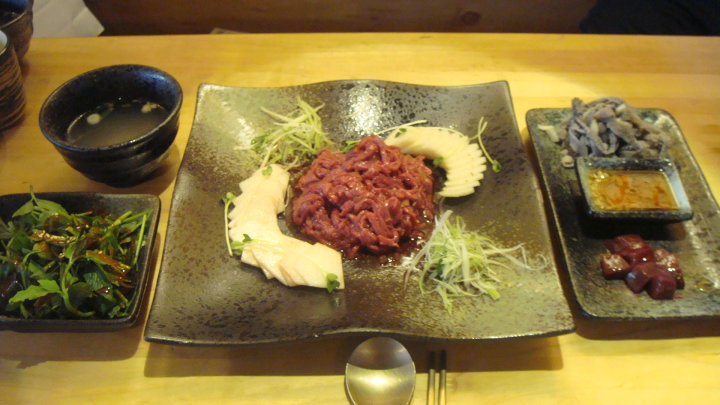Adventurous Korean Food: Korean Beef Sashimi (Tartare) Posted by Tony Kitchen on Jan 17, 2014 in Uncategorized
For the adventurous eater, running out of gastronomical options in Korea is like an empire running out places to expand. Yuk-whey (육회), Korean beef sashimi (a take on steak tartare), is one of the more ambitious, yet unknown, foods in Korea. And it’s a delight.
Korean beef sashimi has stayed out of the mainstream conversations of adventurous eating. Perhaps, the fact that one is eating raw beef—the blood visible, though a mere ounce of it—leaves most to think, Won’t I get sick?
What makes beef sashimi edible is close attention to the meat: the cow is killed and for the next 20 hours the refrigerated skin, meat, and bacteria levels are closely monitored. The meat is sent to the restaurant and served within 48 hours of the cow’s death. The result is succulent beef sashimi that is easy on the stomach.
At most restaurants, there are two options: standard beef sashimi and marinated beef sashimi. The marinated beef sashimi (양념육회) is the recommended choice for those who are first timers. The beef has a quality that seems like it has been marinated in butter, but instead it is sesame seed oil. It’s served julienned: long, thin noodle-like pieces flanked by small Korean pear (배) slices. The taste is sweet, one bite and the meat dissolves on the tongue.
The side dishes are more gastronomically courageous than curious: cow liver (간) and cow stomach (쳔엽). The cow liver is maroon and cube-shaped—a little rough on the outside, but soft and tender on the inside. There is a faint taste of blood, but no juice. It is quite obvious, though, that one is eating raw liver. The other half of the plate is a pile of long, thin strips of grey cow stomach—the cow’s third stomach. Usually, cow stomach has a strong odor because, well, it’s a stomach. If the odor is gone, the stomach has been scrubbed for several hours until there is no smell, and really no flavor. It is recommended to dip the stomach into sesame seed oil and salt. The texture is like a chewy octopus.
Of course, this is a food that pairs perfectly with soju (소주). Perhaps it is the affluent Koreans drinking food. (A typical order for two is 20,000-30,000won (2만~3만원.) Quality raw beef is not something bargain hunt for.)
The typical menu also offers beef sashimi bibimbap (비빔밥). You can try a few strips of the marinated beef sashimi without committing to the minimum serving of 150 grams. The main courses come with porridge, salad with cucumber sauce, and a miso-like broth made from boiled beef.
The result is a mouth-watering marinated beef sashimi, and a sense of fears overcome. It’s not merely an answer to “What crazy things did you try in Korea?” It’s a feeling that a gastronomical territory has been expanded.

Build vocabulary, practice pronunciation, and more with Transparent Language Online. Available anytime, anywhere, on any device.




